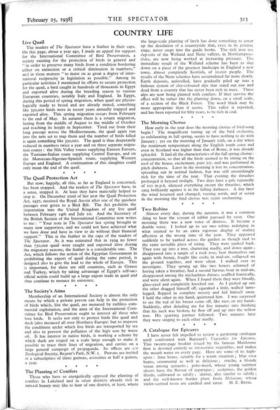COUNTRY LIFE
Live Quail The readers of The Spectator have a feather in their caps. On this page, about a year ago, I made an appeal for support for the International Committee of Bird Preservation, a society existing for the protection of birds in general and " in order to preserve many birds from a condition bordering either on extinction or a critical diminution in numbers," an i in these matters " to insist on as great a degree of inter- national reciprocity in legislation as possible." Among its particular activities I mentioned its efforts to secure protection for the quail, a bird caught in hundreds of thousands in Egypt and exported alive during the breeding season to various European countries, notably Italy and England. In Egypt, during this period of spring migration, when quail are physio- logically ready to breed and are already mated, something like 350,000 birds were in recent years annually trapped and exported alive. This spring migration occurs from February to the end of May. In autumn there is a return migration, lasting from the middle of August to the middle of October and reaching its height in September. Tired out from their long passage across the Mediterranean, the quail again run into the nets set to trap them and the number of birds killed is again something like 350,000. The quail is thus desperately reduced in numbers twice a year and on three separate migra- tion routes : the Nile Valley routes supplying Eastern Europe, the Tunisian-Italian route supplying Central Europe, and on the Moroccan-Algerian-Spanish route, supplying Western Europe and England. A continuation of this slaughter could only mean the end of the quail.
















































 Previous page
Previous page